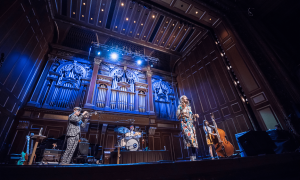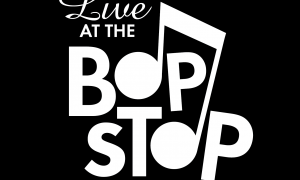Goodman pressed on, but a cross-country tour in 1935 as part of NBC's weekly Let's Dance radio show was a near disaster. That is, until Wednesday, August 21st, when the band played the Palomar Ballroom in Los Angles. NBC in New York had been broadcasting the Let's Dance show on the West Coast leading up to the concert. By the time Goodman took the stage that night, thousands of teens, revved up by the broadcasts, flooded the ballroom to hear the radio band live. From that date forward, Benny was in business.
But success invites company. Over the next three years, the polished swing Goodman had perfected and popularized was rapidly adapted by many of Goodman's musical peers, including Tommy and Jimmy Dorsey, Glenn Miller, Artie Shaw and others. Which pushed Goodman to take his ambitions up a notch. Known as the King of Swing, a name Gene Krupa had given him, Goodman in January 1938 performed at Carnegie Hall, winning over a largely classical music crowd curious to hear what all the fuss was about.
But if 1938 started with a bang for Goodman, his position as top-dog swing clarinetist would be seriously challenged mid-year by long-time rival Artie Shaw [pictured]. Shaw's more mournful and cooler upper-register phrasing on the clarinet made hits in 1938 and 1939 of Begin the Beguine, Back Bay Shuffle, Nightmare and Star Dust. Not only was Shaw more suave looking than Goodman and a more brooding player, he also was recording for Bluebird, Goodman's own label. Goodman didn't like to share.
Fed up with Shaw's me-too clarinet and RCA Victor's gleeful hands-off decision to let the two big two money-makers slug it out for dominance, Goodman in mid-1939 decided to leave RCA for Columbia. In all likelihood, the move was spurred by John Hammond [pictured], Goodman's soon-to-be brother-in-law and prominent Columbia producer. For the next 19 years, Goodman would record on and off for the label, which captured some of his strongest studio work.
Which brings me to the point of this post. Mosaic Records has done the unthinkable. The label has just issued Classic Columbia and Okeh Benny Goodman Orchestra Sessions (1939-1958), a seven-CD box set of Goodman's instrumental recordings for the label. Mosaic wisely left off the vocal tracks, saving them, perhaps, for another box.
After giving the set five complete listens, I must say it's an absolutely stunning box for anyone who loves swing. From the earliest tracks in August 1939, through the 1941 post-War band, to the aggressive 1945-46 band and finally the reflective 1950s sessions, you hear an artist in complete control of his big bands and their remarkable output. Mosaic's restoration by Malcolm Addey is beyond belief, as are Loren Schoenberg's [pictured] liner notes, which appear in a glossy, 32-page, photo-filled booklet. Loren has a big edge here, having known Benny personally from the 1970s until the bandleader's death in 1986.
What strikes me most about this landmark box is the warmth of the fidelity and musical narrative that unfolds. As you listen to Goodman's amazing bands over this 19-year period, you hear evolving shades of cockiness and confidence. You always hear Goodman swinging for the fences but you also experience the mastery of individual musicians who shaped the different bands' personalities.
You also hear things you never heard before on previously issued Columbia recordings of Goodman. When I put on the first Mosaic CD, I was taken aback by the sonic quality. I can only liken it to someone pulling a cloth off a 1940s car that's in mint condition. You admire the original paint job, the curves, the smell of the leather interior and the dashboard details. As you listen, you realize this is about as close to hearing Goodman live as you're going to get. At times, the music is so vivid you feel as if you're standing at the lip of a bandstand. Best of all, with this box you get to hop in and hear the Goodman band's gears shift, starting with Goodman's Shaw sound-alike orchestra in 1939 and 1940 and finishing with bands in 1951 and 1958--one wide-open and swinging and the other more pensive with strings.
As Loren Schoenberg points out in his comprehensive notes, Goodman and Shaw were fierce, almost adolescent rivals. When Shaw's popularity started to soar in 1938 and 1939, much of the clarinetist's appeal came from the sound he produced on the high end of the instrument. So when Goodman switched to Columbia, you hear him emulating Shaw's sound in an effort to kick up dirt and push back. Goodman's Shavian approach is most evident and startling on Night and Day and Frenesi from 1939.
By the end of 1940, Benny seems to have let go of his Shaw kick. The following year, the band started to become more jaunty and jazzy, recording songs like Take It (arranged by Margie Gibson), Fiesta in Blue with Cootie Williams [pictured], and Eddie Sauter's visionary charts for Don't Be That Way, Birth of the Blues and Ramona. In 1942, you hear Mel Powell's conversational arrangements and piano playing that teased out a new Goodman sound and changed the band's feel.
The next “gear shift" came in 1945, when Goodman's band took on a much brassier, sassier sound. You can almost hear the influence of bop and the unbridled optimism of World War II's wind-down. This coltish spirit is most evident on Eddie Sauter's [pictured] Gotta Be This or That and Fletcher Henderson's Just You Just Me, Baby Won't You Please Come Home and Fascinating Rhythm. Perhaps the stunner from this period is a fresh reading of Henderson's Somebody Stole My Gal. The band snaps like fireworks at every turn. You also have the cooler swing of Sauter's Lucky, with alternate takes that feature Buddy Rich on drums.
By 1951, the Goodman orchestral sound is wide open, playing mostly Henderson arrangements that integrate swing with airier and punchier call-and-response patterns. There's less heat in this period than in earlier bands, which isn't bad. It's just different. The Goodman orchestra is so polished and pure here that these late Columbia recordings merely confirm what you already knew: Goodman was in a class by himself. Think of these years as cruising speed. Just listen to revamped versions of King Porter Stomp and When Buddha Smiles. I actually found myself enjoying this period most, where the emphasis was on framing a relaxed Goodman. Or dig the Paul Weston-arranged string sessions that included Georgia on My Mind, I Didn't Know What Time It Was and I Got a Right to Sing the Blues. They're about as beautiful as beautiful gets.
For me, this box is a blessing in so many ways. If you love swing, the set is like owning a Rolex or a fine piece of furniture.
The craftsmanship is subtle and unmistakable, and you instantly know you're in the presence of unparalleled greatness. In addition, this box is one of those rare instances where I actually welcomed hearing alternate takes. Even during the 1950s recordings, my foot was snapping unconsciously against the base of my swivel chair. You can't help it.
Unless something else comes along in the next four weeks, this is the box set of the year, hands down. I wish I had something to say that was critical or could share with you a flaw or two. But I can't. Benny, for all of his personal quirks, never sounded so glorious over such a long period of time. And thanks to the loving restoration of the music, you'll finally understand why so many fox-trotters stopped dancing mid-song to stare. It all makes perfect sense now.
Tomorrow, a conversation with Loren Schoenberg, tenor saxophonist, writer, executive director of the National Jazz Museum in Harlem and author of the superb liner notes that accompany Mosaic's new Benny Goodman box. In addition to working with Goodman on several archival projects during the late 1970s and early 1980s, Loren led a big band that Goodman took over. Tomorrow, Loren provides an unvarnished and authoritative view of the King of Swing complete with insight into these important swing recordings.
JazzWax video clip: Here's a video promo for the Benny Goodman box set along with comments by Loren Schoenberg:
This story appears courtesy of JazzWax by Marc Myers.
Copyright © 2026. All rights reserved.


























